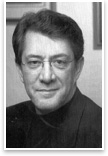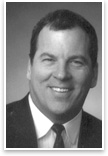| |
Seven Outstanding Professionals Tapped for Hon. AIA
Summary: Please join us in welcoming seven very special people into the AIA family. Despite disparate roles, they all are people who, although not architects by profession, have offered distinguished service to the profession of architecture or the allied arts and sciences, and thus have made all of our lives richer. One of the most important messages we share is our gratitude toward those who support and uplift architects and architecture; in this spirit, the Institute is very pleased to bestow on these seven individuals the title of Honorary AIA.
 Ron
Bogle, Hon. AIA, as president and CEO of the American Architectural
Foundation since 2002, has forged a close and successful relationship
with the AIA that has benefited both organizations. In association
with the National Endowment for the Arts and the U.S. Conference
of Mayors, Bogle is managing partner for the Mayors’ Institute
on City Design, through which architects and mayors serve as resource
members dealing with such issues as neighborhood development, downtown
revitalization, university/city partnerships, and transportation.
Bogle also worked closely with the AIA Committee on Architecture
for Education to launch the Great Schools by Design program, which
encourages collaboration in the design process and promotes good
design, as well as the 2005 National Summit on School Design. Prior
to leading the AAF, Bogle served as a leading agent for change
in transforming Oklahoma City’s downtown and schools, including
as campaign director of that city’s highly successful Metropolitan
Area Projects Plan. “The connection that exists between the
AIA and the American Architectural Foundation has noticeably improved
as a direct result of Ron’s leadership,” noted the
jury. Ron
Bogle, Hon. AIA, as president and CEO of the American Architectural
Foundation since 2002, has forged a close and successful relationship
with the AIA that has benefited both organizations. In association
with the National Endowment for the Arts and the U.S. Conference
of Mayors, Bogle is managing partner for the Mayors’ Institute
on City Design, through which architects and mayors serve as resource
members dealing with such issues as neighborhood development, downtown
revitalization, university/city partnerships, and transportation.
Bogle also worked closely with the AIA Committee on Architecture
for Education to launch the Great Schools by Design program, which
encourages collaboration in the design process and promotes good
design, as well as the 2005 National Summit on School Design. Prior
to leading the AAF, Bogle served as a leading agent for change
in transforming Oklahoma City’s downtown and schools, including
as campaign director of that city’s highly successful Metropolitan
Area Projects Plan. “The connection that exists between the
AIA and the American Architectural Foundation has noticeably improved
as a direct result of Ron’s leadership,” noted the
jury.
 Amory Lovins, Hon. AIA, for more than
three decades has elaborated the theme of “end-use/least cost” to
lead a revolution toward more efficient, appropriately scaled, renewable-resource
energy use in this country and abroad. His whole-system design concept
incorporates techniques of huge energy savings over traditional systems
while costing less. In the built environment, Lovins has led or been
a key participant in more than 100 exemplary super-efficient design
efforts, including his owner-built, super-efficient home/office in
Snowmass, Colo., which after 22 years still ranks among the world’s
most efficient and highly integrated buildings. In 1982, he cofounded
the Rocky Mountain Institute, a 55-person, $8 million/year nonprofit “think-and-do” tank,
which recently garnered a 2007
AIA Award for Collaborative Achievement. He has authored 25 books
(including the seminal Soft
Energy Paths in 1979) and hundreds of articles and delivered
thousands of lectures on energy. Lovins has served as a lecturer
and visiting professor in the U.S., Asia, and Europe, and has received
nine honorary doctorates from U.S. and British schools. “Amory
Lovins holds a unique position as a pioneer in the area of energy
conservation and sustainability,” said the jury. “Amory
was an inventor of a movement that is now mainstreamed and institutionalized
a process that is now common: To collect the talent of other people
and use them as a resource.” Amory Lovins, Hon. AIA, for more than
three decades has elaborated the theme of “end-use/least cost” to
lead a revolution toward more efficient, appropriately scaled, renewable-resource
energy use in this country and abroad. His whole-system design concept
incorporates techniques of huge energy savings over traditional systems
while costing less. In the built environment, Lovins has led or been
a key participant in more than 100 exemplary super-efficient design
efforts, including his owner-built, super-efficient home/office in
Snowmass, Colo., which after 22 years still ranks among the world’s
most efficient and highly integrated buildings. In 1982, he cofounded
the Rocky Mountain Institute, a 55-person, $8 million/year nonprofit “think-and-do” tank,
which recently garnered a 2007
AIA Award for Collaborative Achievement. He has authored 25 books
(including the seminal Soft
Energy Paths in 1979) and hundreds of articles and delivered
thousands of lectures on energy. Lovins has served as a lecturer
and visiting professor in the U.S., Asia, and Europe, and has received
nine honorary doctorates from U.S. and British schools. “Amory
Lovins holds a unique position as a pioneer in the area of energy
conservation and sustainability,” said the jury. “Amory
was an inventor of a movement that is now mainstreamed and institutionalized
a process that is now common: To collect the talent of other people
and use them as a resource.”
 Elizabeth Mitchell, Hon. AIA, “is a consensus builder who has done a wonderful job of putting architects in leadership positions in her community of Salt Lake City and the state of Utah,” said the jury. The executive director of AIA Utah has made outstanding contributions to the profession or architecture and the AIA for more than 20 years. During that time, Mitchell has been key to AIA Utah’s government affairs efforts and has worked hard to build positive relationships between chapter members and state executive branch policymakers, including the Division of Facilities Construction and Management, Division of Occupational and Professional Licensing, and the Utah State Architects Licensing Board. She also has helped expand the influence of the AIA through helping to secure appointments of chapter members to the Architects Licensing Board, Seismic Safety Commission, State Capitol Arts Placement Commission, Uniform Building Code Commission, and the Capitol Preservation Board. In addition to her efforts for AIA Utah, Mitchell has been an active member of the Council of Architectural Component Executives (CACE) and served as CACE president in 2006 and as a member of the Board of Directors Executive Committee, as well as the Component Partnerships, Board Community, and Livable Communities committees and the national Long Range Planning Advisory Group. Elizabeth Mitchell, Hon. AIA, “is a consensus builder who has done a wonderful job of putting architects in leadership positions in her community of Salt Lake City and the state of Utah,” said the jury. The executive director of AIA Utah has made outstanding contributions to the profession or architecture and the AIA for more than 20 years. During that time, Mitchell has been key to AIA Utah’s government affairs efforts and has worked hard to build positive relationships between chapter members and state executive branch policymakers, including the Division of Facilities Construction and Management, Division of Occupational and Professional Licensing, and the Utah State Architects Licensing Board. She also has helped expand the influence of the AIA through helping to secure appointments of chapter members to the Architects Licensing Board, Seismic Safety Commission, State Capitol Arts Placement Commission, Uniform Building Code Commission, and the Capitol Preservation Board. In addition to her efforts for AIA Utah, Mitchell has been an active member of the Council of Architectural Component Executives (CACE) and served as CACE president in 2006 and as a member of the Board of Directors Executive Committee, as well as the Component Partnerships, Board Community, and Livable Communities committees and the national Long Range Planning Advisory Group.
 Lorna McRae Parsons, Hon. AIA, as
head of Victor O. Schinnerer’s professional liability insurance
program, has for the past decade demonstrated creative leadership,
responsiveness to the needs of architecture firms, and dedication
to the promotion of the architecture profession. In fact, for the
last 25 years, Parsons has worked with architecture firms to provide
information to enable them to expand their services to clients while
assessing their risk in doing so. Throughout her leadership, the
AIA-commended program run by Schinnerer has steadfastly countered
the trend of the insurance industry to dictate how architects practice.
Specifically, Parsons has fought for certificates of merit prior
to legal action, abolishment of liability laws that unfairly penalize
architects, special statutes that protect architects doing pro bono
work, and statutes of repose that allow architects to plan long-term
career objectives. According to the awards jury, “Lorna Parsons
represents the value that the AIA has received from Victor O. Schinnerer
and in a larger sense, highlights the value of support that is integral
to our success.” Lorna McRae Parsons, Hon. AIA, as
head of Victor O. Schinnerer’s professional liability insurance
program, has for the past decade demonstrated creative leadership,
responsiveness to the needs of architecture firms, and dedication
to the promotion of the architecture profession. In fact, for the
last 25 years, Parsons has worked with architecture firms to provide
information to enable them to expand their services to clients while
assessing their risk in doing so. Throughout her leadership, the
AIA-commended program run by Schinnerer has steadfastly countered
the trend of the insurance industry to dictate how architects practice.
Specifically, Parsons has fought for certificates of merit prior
to legal action, abolishment of liability laws that unfairly penalize
architects, special statutes that protect architects doing pro bono
work, and statutes of repose that allow architects to plan long-term
career objectives. According to the awards jury, “Lorna Parsons
represents the value that the AIA has received from Victor O. Schinnerer
and in a larger sense, highlights the value of support that is integral
to our success.”
 Edward F. Sanderson, Hon. AIA, executive director of the Rhode Island Historic Preservation and Heritage Commission, has tirelessly promoted the importance of good design in the transformation of thousands of unused and derelict properties into award-winning buildings and communities, not only in Rhode Island but throughout the U.S. His 25 years of hard work in the Ocean State as state preservation officer have other jurisdictions looking to Rhode Island for an understanding of how rehabilitation of historic buildings can enrich lives and economies through fusing of contemporary and historic architecture. Additionally, Sanderson’s presentations to the public—as well as his work as an appointed member of the Secretary of the Interior’s 2006 Committee to Review the Federal Historic Preservation Tax Credit—have profoundly changed perception of preservation projects. “Ted Sanderson has testified in front of congressional committees—which in itself is a big job—and also has leveraged his position to a stronger role that carries greater influence by serving on the President’s Advisory Council on Historic Preservation and the White House’s Preserve America Summit,” extols the jury. Edward F. Sanderson, Hon. AIA, executive director of the Rhode Island Historic Preservation and Heritage Commission, has tirelessly promoted the importance of good design in the transformation of thousands of unused and derelict properties into award-winning buildings and communities, not only in Rhode Island but throughout the U.S. His 25 years of hard work in the Ocean State as state preservation officer have other jurisdictions looking to Rhode Island for an understanding of how rehabilitation of historic buildings can enrich lives and economies through fusing of contemporary and historic architecture. Additionally, Sanderson’s presentations to the public—as well as his work as an appointed member of the Secretary of the Interior’s 2006 Committee to Review the Federal Historic Preservation Tax Credit—have profoundly changed perception of preservation projects. “Ted Sanderson has testified in front of congressional committees—which in itself is a big job—and also has leveraged his position to a stronger role that carries greater influence by serving on the President’s Advisory Council on Historic Preservation and the White House’s Preserve America Summit,” extols the jury.
 Stephen A. Wynn, Hon, AIA, “has shown us the importance of a design partner/client relationship. He has led the way in rebranding architecture as a built experience,” said the jury. “He is a benefactor to the industry, a great supporter of architecture, and has made fine art a public event. “ His nominators and supporters describe Wynn as “a veritable Medici,” who has harnessed his ambitions for his hometown and his business skills to the creativity and technical know-how of the architecture profession. Through a series of daring commissions—the Wynn Las Vegas, The Mirage, Treasure Island, and Bellagio hotels—Wynn has transformed the face of Las Vegas, re-branding his city as a world-class destination, enriching the economic vitality of his community, and enhancing the role of the “client as design partner and the architect as miracle worker.” Wynn was named one of the “Worlds 100 Most Influential People” by Time magazine in 2006 and holds honorary doctorates from the University of Nevada and Sierra Nevada College. Stephen A. Wynn, Hon, AIA, “has shown us the importance of a design partner/client relationship. He has led the way in rebranding architecture as a built experience,” said the jury. “He is a benefactor to the industry, a great supporter of architecture, and has made fine art a public event. “ His nominators and supporters describe Wynn as “a veritable Medici,” who has harnessed his ambitions for his hometown and his business skills to the creativity and technical know-how of the architecture profession. Through a series of daring commissions—the Wynn Las Vegas, The Mirage, Treasure Island, and Bellagio hotels—Wynn has transformed the face of Las Vegas, re-branding his city as a world-class destination, enriching the economic vitality of his community, and enhancing the role of the “client as design partner and the architect as miracle worker.” Wynn was named one of the “Worlds 100 Most Influential People” by Time magazine in 2006 and holds honorary doctorates from the University of Nevada and Sierra Nevada College.
 L. William Zahner, Hon. AIA, is the fourth generation of his family to lead the A. Zahner Company, which has supplied high-quality architectural metal products and services for more than 100 years. “He has taken what we still think of as a craft and elevated it to an art form,” the jury commented. Like his other supporters and nominators, Thom Mayne, FAIA, calls him an “absolute leader in innovation, consistently pushing the tectonic limits of architecture. His total commitment to exploration and innovation makes him an integral part of our design team.” Zahner is highly valued and has been honored in the metals, design, engineering, and artistic, and construction communities for study, research, and experimentation that result in creative and dignified architectural expressions. Zahner has advanced the knowledge and understanding of building skin design through research, training, seminars, lectures, and collaboration. He also holds two patents on roofing systems. Zahner’s current release, Architectural Metal Surfaces, published by John Wiley and Sons (2004), is considered to be “essential text for understanding the composition of metals, their properties, and possibilities,” writes Marlon Blackwell, AIA, in his letter of support. L. William Zahner, Hon. AIA, is the fourth generation of his family to lead the A. Zahner Company, which has supplied high-quality architectural metal products and services for more than 100 years. “He has taken what we still think of as a craft and elevated it to an art form,” the jury commented. Like his other supporters and nominators, Thom Mayne, FAIA, calls him an “absolute leader in innovation, consistently pushing the tectonic limits of architecture. His total commitment to exploration and innovation makes him an integral part of our design team.” Zahner is highly valued and has been honored in the metals, design, engineering, and artistic, and construction communities for study, research, and experimentation that result in creative and dignified architectural expressions. Zahner has advanced the knowledge and understanding of building skin design through research, training, seminars, lectures, and collaboration. He also holds two patents on roofing systems. Zahner’s current release, Architectural Metal Surfaces, published by John Wiley and Sons (2004), is considered to be “essential text for understanding the composition of metals, their properties, and possibilities,” writes Marlon Blackwell, AIA, in his letter of support.
|
|


 Ron
Bogle, Hon. AIA,
Ron
Bogle, Hon. AIA, Amory Lovins, Hon. AIA,
Amory Lovins, Hon. AIA, Elizabeth Mitchell, Hon. AIA,
Elizabeth Mitchell, Hon. AIA, Lorna McRae Parsons, Hon. AIA,
Lorna McRae Parsons, Hon. AIA, Edward F. Sanderson, Hon. AIA,
Edward F. Sanderson, Hon. AIA, Stephen A. Wynn, Hon, AIA,
Stephen A. Wynn, Hon, AIA, L. William Zahner, Hon. AIA,
L. William Zahner, Hon. AIA,